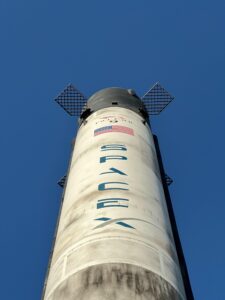SpaceX Launched Military Satellites Designed to Track
Hypersonic Missiles

source: wired.com | image: pexels.com
The prototype satellites hitched a ride on a Falcon 9 rocket.
Two prototype satellites for the Missile Defense Agency and four missile-tracking satellites for the US Space Force rode a SpaceX Falcon 9 rocket into orbit Wednesday from Florida’s Space Coast.
These satellites are part of a new generation of spacecraft designed to track hypersonic missiles launched by China or Russia and perhaps emerging missile threats from Iran or North Korea, which are developing their own hypersonic weapons.
Hypersonic missiles are smaller and more maneuverable than conventional ballistic missiles, which the US military’s legacy missile defense satellites can detect when they launch. Infrared sensors on the military’s older-generation missile tracking satellites are tuned to pick out bright thermal signatures from missile exhaust.
Hypersonic missiles represent a new challenge for the Space Force and the Missile Defense Agency (MDA). For one thing, ballistic missiles follow a predictable parabolic trajectory that takes them into space. Hypersonic missiles are smaller and comparatively dim, and they spend more time flying in Earth’s atmosphere. Their maneuverability makes them difficult to track.
A nearly five-year-old military organization called the Space Development Agency (SDA) has launched 27 prototype satellites over the last year to prove the Pentagon’s concept for a constellation of hundreds of small, relatively low-cost spacecraft in low-Earth orbit. This new fleet of satellites, which the SDA calls the Proliferated Warfighter Space Architecture, will eventually number hundreds of spacecraft to track missiles and relay data about their flight paths down to the ground. The tracking data will provide an early warning to those targeted by hypersonic missiles and help generate a firing solution for interceptors to shoot them down.
The SDA constellation combines conventional tactical radio links, laser inter-satellite communications, and wide-view infrared sensors. The agency, now part of the Space Force, plans to launch successive generations, or tranches, of small satellites, each introducing new technology. The SDA’s approach relies on commercially available spacecraft and sensor technology and will be more resilient to attack from an adversary than the military’s conventional space assets. Those legacy military satellites often cost hundreds of millions or billions of dollars apiece, with architectures that rely on small numbers of large satellites that might appear like a sitting duck to an adversary determined to inflict damage.
Four of the small SDA satellites and two larger spacecraft for the Missile Defense Agency were aboard a SpaceX Falcon 9 rocket when it lifted off from Cape Canaveral Space Force Station at 5:30 pm EST (2230 UTC) Wednesday.
The SDA’s four tracking satellites, built by L3Harris, are the last spacecraft the agency will launch in its prototype constellation, called Tranche 0. Beginning later this year, the SDA plans to kick off a rapid-fire launch campaign with SpaceX and United Launch Alliance to quickly build out its operational Tranche 1 constellation, with launches set to occur at one-month intervals to deploy approximately 150 satellites. Then, there will be a Tranche 2 constellation with more advanced sensor technologies.
The primary payloads aboard Wednesday’s launch were for the Missile Defense Agency. These two Hypersonic and Ballistic Tracking Space Sensor (HBTSS) satellites, one supplied by L3Harris and the other by Northrop Grumman, will demonstrate medium field-of-view sensors. Those sensors can’t cover as much territory as the SDA satellites but will provide more sensitive and detailed missile tracking data.
“Our advanced satellites on orbit will bring the integrated and resilient missile warning and defense capabilities the US requires against adversaries developing more advanced maneuverable missiles,” said Christopher Kubasik, chairman and CEO of L3Harris. “L3Harris delivered this advanced missile tracking capability on behalf of MDA and SDA on orbit in just over three years after work was authorized to proceed. We are proud to be a critical part of the new space sensing architecture.”
The HBTSS satellites, valued at more than $300 million, and the SDA’s tracking prototypes will participate in joint military exercises in the coming months, where the wide-view SDA satellites will provide “cueing data” to the MDA’s HBTSS spacecraft. The narrower field of view of the HBTSS satellites can provide more specific, target-quality data to a ground-based interceptor, according to a report last year published by the Congressional Research Service. Future tranches, or generations, of SDA satellites will incorporate the medium field-of-view sensing capability flying on the MDA’s HBTSS satellites.
With SDA taking over the responsibility for making this technology operational, that will leave the MDA, which has historically flown its own missile-tracking satellites, focused on next-generation sensor development, an MDA spokesperson told Ars.
Military officials decided only last year to place the four SDA satellites on the same launch as the MDA’s HBTSS mission. With all six satellites flying in the same orbital plane, there will be opportunities to see the same targets with both types of spacecraft and sensors. These targets may include scheduled US military missile tests or foreign launches.
“The intent is to be able to work with cooperative and noncooperative targets to be able to do our demonstrations,” a senior SDA official said during a background briefing.
This story originally appeared on Ars Technica.
